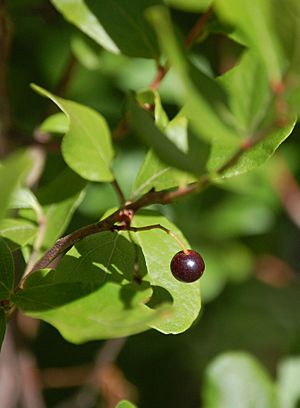Black huckleberry facts for kids
Quick facts for kids Black huckleberry |
|
|---|---|
 |
|
| Scientific classification | |
| Genus: |
Gaylussacia
|
| Species: |
baccata
|
| Synonyms | |
|
List
Andromeda baccata Wangenh. 1787
Decachaena baccata (Wangenh.) Small Adnaria resinosa (Torr. & A.Gray) Kuntze Decamerium resinosum Nutt. Gaylussacia resinosa (Aiton) Torr. & A.Gray Vaccinium glabrum P.Watson Vaccinium parviflorum Andrews Vaccinium resinosum Aiton |
|
Gaylussacia baccata, commonly called the black huckleberry, is a popular shrub found across a wide area of eastern North America. It's known for its sweet, dark berries that are enjoyed by both people and animals.
Contents
Where Does Black Huckleberry Grow?
This plant is native to many parts of North America. You can find it in Eastern Canada and the Great Lakes region. It also grows in the Midwestern and Northeastern United States. Its range extends south through the Appalachian Mountains and into the Southeastern United States.
Black huckleberry grows from Newfoundland in the east, all the way west to Manitoba and Minnesota. It can be found as far south as Arkansas, Alabama, and Georgia.
What Does Black Huckleberry Look Like?
The black huckleberry looks a lot like native blueberry plants. They often grow together in the same places. However, you can tell them apart by looking closely at the leaves. Black huckleberry leaves have tiny, shiny resin dots on their undersides. These dots sparkle when you hold a leaf up to the light.
This shrub can grow up to 150 centimeters (about 5 feet) tall. It often forms large groups or colonies. Its flowers hang in small clusters of 3 to 7. They are bell-shaped and can be orange or red. The berries are usually a very dark blue, almost black. Sometimes, you might even find rare white berries!
The berries are very sweet and tasty. People love to eat them fresh. They are also used to make jellies, or baked into delicious treats like pancakes and muffins.
Why is Black Huckleberry Important?
The black huckleberry plays an important role in its environment. It serves as a food source and home for several types of insect larvae. For example, it is a host plant for the caterpillars of certain moths and butterflies. These include the brown elfin butterfly, the Gordian sphinx moth, Henry's elfin butterfly, and the huckleberry sphinx moth. These insects rely on the plant for their early life stages.
More About Black Huckleberry
 In Spanish: Gaylussacia baccata para niños
In Spanish: Gaylussacia baccata para niños

